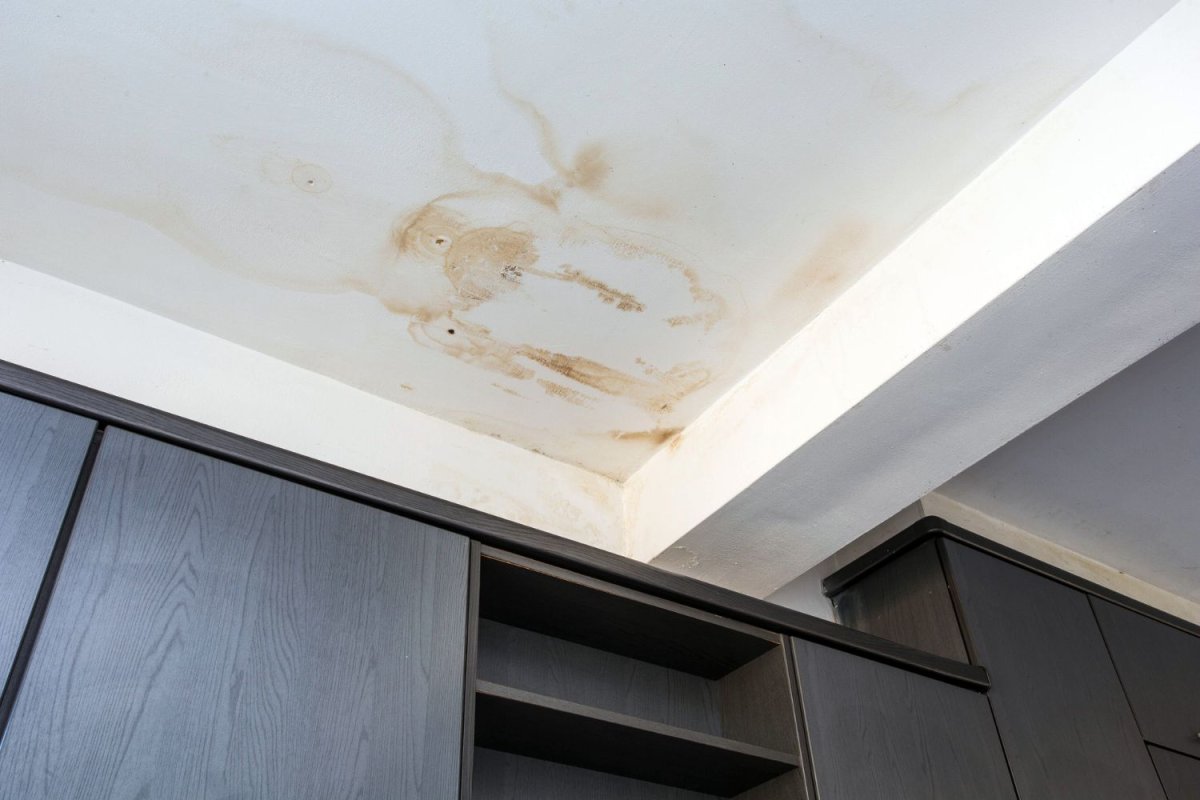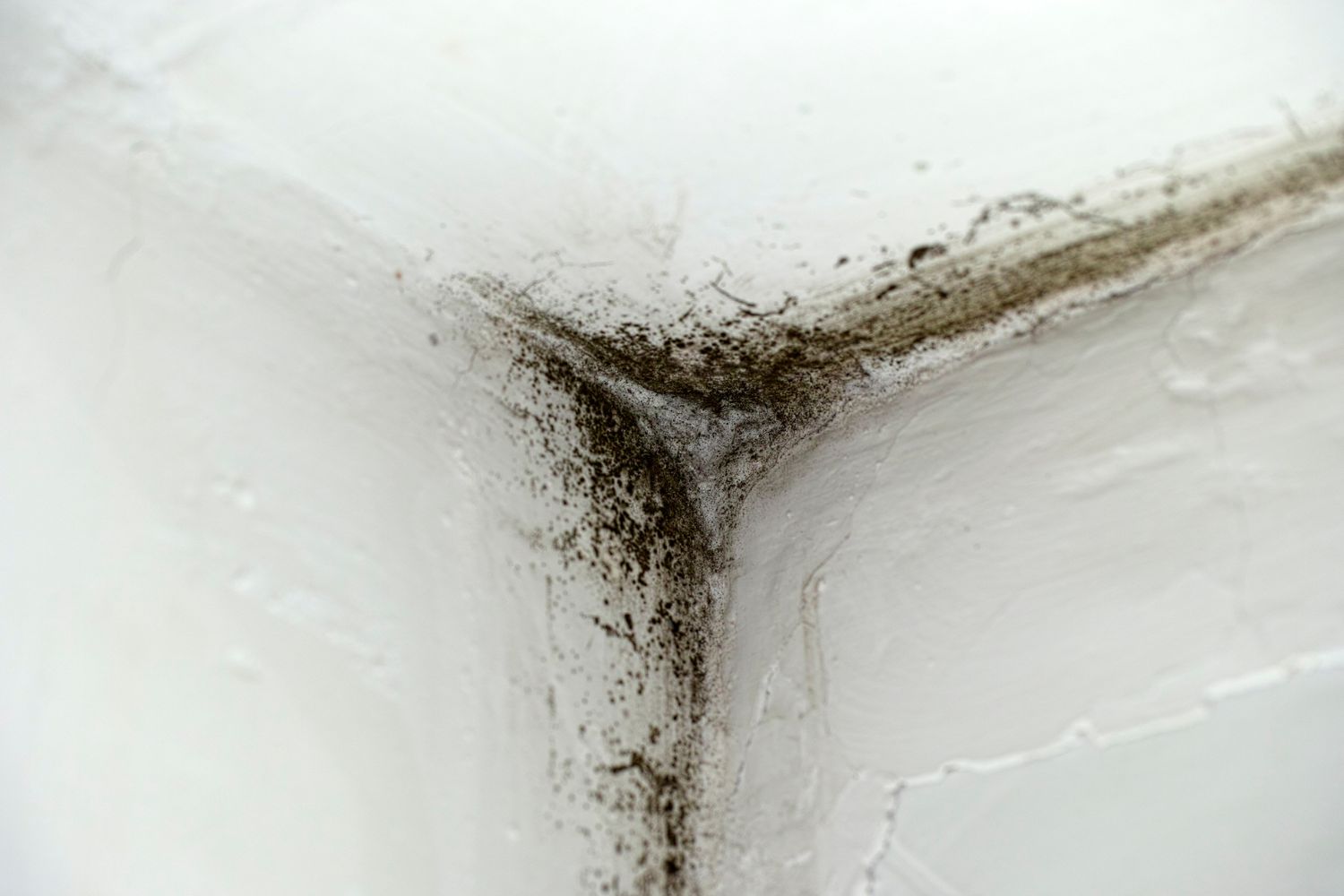

We may earn revenue from the products available on this page and participate in affiliate programs. Learn More ›
No one wants to find unsightly water damage or mold in their home. These issues go beyond mere aesthetics, though: Not only do they pose potential threats to the structural integrity of a property, but in some cases, they can be a health hazard for a home’s occupants.
While water damage and mold can stem from similar causes—such as leaks, flooding, or excessive humidity—they manifest differently and require unique approaches for remediation. Importantly, water damage can quickly give way to mold growth if left unchecked, so it’s important to identify and address both problems as early as possible.
Homeowners will want to familiarize themselves with the distinctive signs of water damage vs. mold, along with what steps to take next to ensure a safe and habitable environment.
1. Water damage and mold are differentiated by a few key characteristics. Visually, mold can take on a variety of colors like white, green, or black, whereas water damage stains are typically yellow or brown.
Homeowners wondering how to tell the difference between water damage and mold can start with a visual inspection of the area. Though moisture is the culprit behind both issues, they present distinctly different visual cues that can be used to identify them.
Mold, a fungal growth that thrives in damp conditions, can vary in appearance, texture, and color. Depending on the species and the environment, mold, especially mold from water damage, can take on shades of white, green, or black. Mold growth may have a speckled appearance and can also change hues over time.
Water damage results from the excessive accumulation or prolonged presence of water. The most obvious sign of water damage in walls is stains that are tinted yellow or brown. These stains may feel damp to the touch and appear as discolorations or patches on walls and ceilings. Water damage stains may occasionally be mistaken for black mold by those who are not familiar with what black mold looks like as both form in circular patterns, but water damage is likely to be lighter with less variation in color.
2. Water damage can cause drywall to bubble or flake, but mold will have a slimy, fuzzy, or powdery texture.
Water damage from leaks, flooding, or persistent humidity can cause noticeable issues in building materials like drywall. When infiltrated by water, drywall and the wallpaper or paint that covers it can bubble, peel, or flake as it absorbs moisture and loses its structural integrity.
On the other hand, mold colonies can present a variety of textures depending on their type and maturity. Molds that are still actively growing can feel slimy and are likely to smear if they are touched. Mold that is inactive can have a fuzzy texture similar to cotton or velvet, and it can even appear powdery and easily dislodge from surfaces when touched.

3. Mold often spreads throughout the home if it remains untreated, but water damage will be limited to areas where water infiltration occurred.
Mold is capable of spreading far beyond its initial point of emergence if left untreated. Even if the problem starts as just a small patch of mold on the ceiling, when spores are released they can travel through the air, settle in various parts of a home, and grow in any location with sufficient moisture and organic material. Water damage, on the other hand, remains localized to areas directly affected by water infiltration or leaks and won’t “travel” the way mold does.
If a homeowner identifies water damage due to a leak, fixing that leak is a critical first step in halting the progression of both water damage and mold. However, simply fixing the leak does not guarantee that the mold will disappear on its own. While it may slow down or halt its growth due to reduced moisture, the existing mold colonies will not spontaneously vanish. To completely kill mold from water damage, active remediation measures, which may include cleaning, disinfecting, and in severe cases, replacement of affected materials, are essential. Moreover, ensuring proper ventilation and maintaining low indoor humidity can prevent future mold growth, even after the initial problem has been addressed.
4. Water damage does not always have a detectable odor, but mold is usually accompanied by a strong musty smell.
Water damage is primarily a visual concern and doesn’t always give away its presence through smell. It may manifest as discolorations, staining, or warping of surfaces without necessarily emitting a discernible scent, especially in the initial stages. Over time, stagnant water or prolonged moisture can sometimes produce a mildewy scent, but this is distinct from mold, which has a more noticeable smell.
As mold grows and multiplies, it often emits a strong musty odor, thanks to microbial volatile organic compounds (MVOCs) that are produced during the mold’s metabolic processes. The damp, stale, or earthy smell of mold is a telltale sign of its presence, even if the growth itself isn’t immediately visible.

5. Water damage itself may not cause adverse health effects, but if mold develops, exposure can lead to symptoms like coughing or sneezing.
Water damage, while detrimental to the structural integrity of homes, doesn’t inherently cause direct adverse health effects to its occupants. However, if left unaddressed, water damage can provide the ideal environment for mold growth.
As mold multiplies, it releases spores and other compounds into the air, which can be inhaled by a home’s occupants. Prolonged or intense exposure to certain mold species can lead to various mold poisoning symptoms, particularly in those with existing allergies or respiratory conditions.
According to the Environmental Protection Agency (EPA),some common symptoms and signs of mold exposure include:
- Coughing
- Sneezing
- Nasal congestion or runny nose
- Throat irritation
- Red, watery, or itchy eyes
- Skin rashes
- Wheezing or difficulty breathing due to lung irritation
- Heightened sensitivity in individuals with asthma
It’s important to note that while not all molds are inherently toxic to humans, prolonged exposure to even nontoxic molds can still trigger allergic reactions or exacerbate existing respiratory conditions in sensitive individuals.
6. However, water damage and mold often go hand-in-hand. Homes that have been affected by water damage have a high risk of developing mold.
Water damage and mold often appear together in homes affected by leaks, flooding, or prolonged moisture exposure. When water damage is not promptly and thoroughly addressed, it creates the ideal damp environment for mold spores to thrive. The combination of moisture, oxygen, and organic materials (like wood, drywall, or carpeting) provides fertile ground for mold to establish and grow in as little as 24 to 48 hours.
Some common types of mold that can grow as a result of water damage in a home include:
- Stachybotrys chartarum. Often referred to as “black mold,” this type of mold has a greenish-black hue and predominantly grows on materials such as paper, dust, and lint. It is common to find black mold in showers or other areas with excessive humidity or water leakage.
- Aspergillus. This mold typically appears to be black with yellow or white shades below the surface. Coming into contact with aspergillus may lead to contracting aspergillosis, which impacts the respiratory system.
- Cladosporium. This mold can appear to be green with black and brown hues. It may appear as tiny dots at first, but it will eventually expand into larger patches. Cladosporium is particularly prevalent in bathrooms and under sinks, but it can also grow on carpets and wallboards.
- Alternaria. This green, gray, and/or black mold can have a velvet-like texture. While alternaria primarily grows outdoors, it can infiltrate homes and take root in walls and attic spaces once it becomes airborne.
It’s imperative for homeowners to call a mold remediation company for an inspection to address and eliminate any water damage mold growth as soon as possible. Mold removal technicians will be able to identify black mold or other toxic varieties like slime molds and advise on the next steps.

7. If a home has recently experienced leaks or flooding, a water damage restoration company can clean any affected areas before mold has a chance to grow.
When a home experiences leaks or flooding, the aftermath can be both immediate and long term. Immediate issues, such as pooled water or dampness, might seem obvious and urgent. However, the long-term ramifications, such as mold growth, structural degradation, and compromised indoor air quality, can be equally, if not more, concerning.
In such scenarios, a homeowner may wish to look into hiring one of the top water damage restoration services in their area. These professionals have the equipment and experience to thoroughly clean, dry, and restore affected areas and greatly reduce the possibility of mold growth. Acting quickly is imperative since mold can begin growing in as little as 24 hours under the right conditions. With the assistance of a professional restoration company, homeowners can effectively address their water damage repair needs and mitigate the risk of mold growth. On average, water damage restoration costs between $1,305 and $5,707. Extensive work like flooded basement cleanup will be at the higher end of this scale, whereas minor leaks will be less costly to address.
After a water damage restoration company’s work is complete, it may be advisable to test for the presence of mold using one of the best mold test kits, and then call a mold inspection company for an inspection.
8. A mold remediation company can eliminate any active mold growth and take measures to prevent it from coming back.
If homeowners notice that mold has begun to grow after water damage is addressed, the next advisable step is researching and hiring a trusted mold removal or remediation company. In addition, vinegar can kill mold in small quantities, as can bleach, but it isn’t advisable to paint over mold or ignore it. Bringing in pros is the best way to ensure that the mold problem hasn’t spread and that mold doesn’t grow back.
The top mold remediation companies may use specialized tools to locate mold (even if it’s hidden behind walls or under floors) and employ a combination of methods, including physical removal of contaminated materials and the use of HEPA vacuums and antimicrobial treatments to kill microscopic mold spores. They may also use containment methods such as negative air pressure and sealing off affected areas to ensure mold doesn’t spread to other areas of the home. Finally, mold remediation professionals can help homeowners identify sources of moisture in their homes and may even provide recommendations on how to maintain a mold-free environment, such as using dehumidifiers, ensuring proper ventilation, or applying mold-resistant paints. Homeowners can expect to pay between $1,125 and $3,439 for mold remediation costs. It’s worth noting that some companies will waive any initial mold inspection costs if they are hired on for remediation services.
By hiring a mold remediation company, a homeowner can both eliminate active mold growth and reduce the risk of future mold issues.
